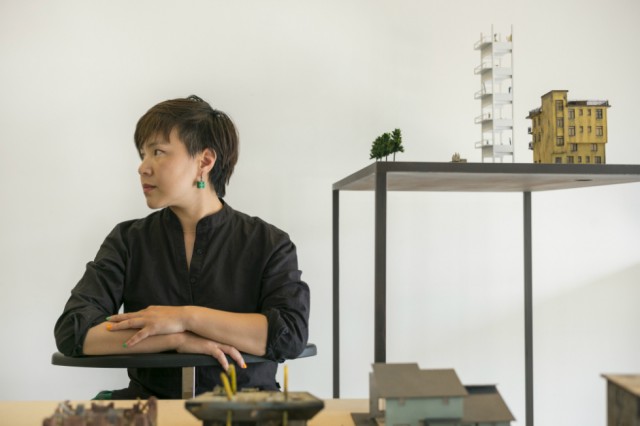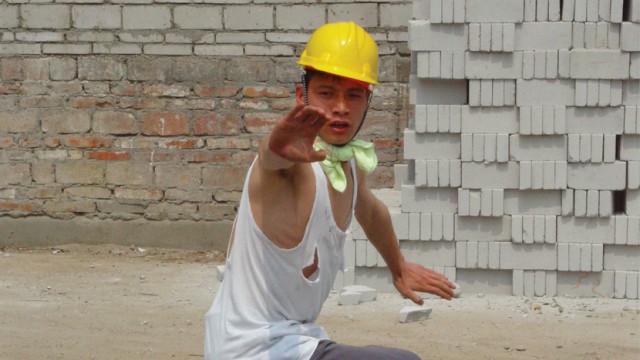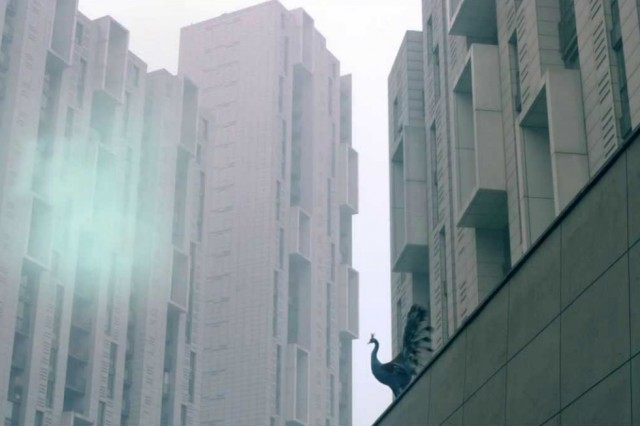“Drama, humour and unconscious performances of the everyday”: Cao Fei At China Visual Festival 2016
Linda Pittwood hears about the threads that bind together the films of contemporary artist Cao Fei: the star guest at this year’s Chinese Visual Festival in London…
In the Q&A, someone asked: “What does it mean to see your work on the big screen, when it was made for the gallery context?” Artist Cao Fei replied, in English, that her work crosses over between video art, film and even new media. She added that the advantage of seeing it on the big screen is that it “forces people to see the work from beginning to end… it makes more sense.”
It’s an apt comment for the opening of Chinese Visual Festival (CVF) 2016, who aim to showcase and explore a combination of cutting-edge contemporary cinema and art from the Chinese-speaking world, and which was held at one of the UK’s most famous cinemas (as opposed to within a gallery space), BFI Southbank. The CVF is also, as it turned out, an opportunity to discuss a rich variety of ongoing political and social issues, like East/West tensions, culture clashes, and Chinese modernity, as well as cross-cultural motifs like Pac-man, hip-hop and avatars, to personal reflections on loneliness and work-life balance.
The CVF launch, therefore, was a good way to summarize the festival’s aims. A double-bill, I saw a selection of six short films, entitled Pulse of the Pearl River Delta, curated by Fei and CVF curator Sylvia Zhen, and then an in-conversation called Cao Fei: It’s a Game!, with Fei, Zhen and Chris Berry of King’s College London, interspersed with six of the artist’s own films. Fei chose to focus on the Pearl River Delta region for her selection because of its “independent” streak; the result, she says, of being further from Beijing. It is her home province, having been born in Gaungzhou – she only “gave in” to the lure of China’s capital in 2006.
Described as “one of the most important and innovative young artists to have emerged on the international scene from China”, one could say Fei is an obvious choice as a focus for such a festival. She has this year had a successful show at PS1 Moma, New York, is in the CFCCA’s 30 year anniversary exhibition, and regularly represents her country at festivals such as Venice Biennale and Documenta. So what did her selections say about her as an artist?
I noticed that the first film she picked, Landscape II (1996) by Chen Shaoxing, is 20 years old. Illustrations of people having sex or the mushroom cloud of a bomb are drawn in sketchy, graffiti style with a sharpie on sheets of plastic from an overhead projector. Someone off-camera holds them shakily between the camera lens and the landscape. Fei observed that the landscapes to her look dated and changed; but to me the lo-fi look and feel of this film is something the art world has never moved on from.
Next, a more ambitious film in the San Yuan Li project, a collaboration between Fei, Ou Ning and the U-Teque collective in Guangzhou. It takes a time for this black and white film to fully settle into its own wit, lyricism and sparkle. Aiming to explore the ‘village-as-city’ phenomenon caused by rapid urbanisation, and the tension between old and new, it achieves more than this. It speaks to the interconnectedness of all things by focussing on architecture and human behaviour.

Flickering scenes are linked to the soundtrack with humour, it constructs patterns in the urban landscape: young women shop, older people exercise, Uygers in white caps linger, men play urhus, children run, feet, legs, fragments, bhuddas, peking opera, the cracks and fissures between buildings in the hutong.
1,2,3,4 (2007-2008) by Zhao Tao exposes another ritual. The artist filmed the real-life morning meetings of staff in various businesses, revealing the absurdity of working life, through a verbal register counting the staff “1,2,3,4…”. In contrast, 29 Years Plus 8 Months and 9 Days (2006-2009) by Qin Jin, albeit also based on numerical measurements, couldn’t be more different; it is slow, intimate, heart-breaking. She irons her garment into oblivion, making it an act of destruction in an otherwise featureless, isolated life.
Observing seven films by/co-created by Cao Fei, but also work that she champions, I can see some threads that run through. The artist has created a ‘pop’ visual language that crosses cultural boundaries, whilst remaining firmly rooted in China. Quirks of Chinese everyday performance recur in her work, such as the older generation exercising and dancing in public; she refers to it in Hip Hop Gaungzhou (2003) as well as in the San Yuan project. Music and dancing are hugely important. Play, as the panel observe, is Fei’s way of opening up China for her audiences.
As the discussion begins, she explains a bit more about Gaungzhou’s free spirit and how growing up there in the 1980s she benefited from an influx of popular culture, film and information from Hong Kong into the southern city, which wouldn’t have reached as far as Beijing in the North. “In Beijing”, she says, “the artists fight with political concepts more directly… in the South they use humour.”

Fei’s works Chain Reaction (2000), which she made whilst studying for her bachelors degree, and Hip Hop Gaungzhou, made just after, are described by co-host Zhen as having a DIY spirit; but to me they are incredibly careful and cleverly made works. The first is a retro futurist horror movie, filtered through a music video sensibility, complete with martini glasses of offal. The latter grew, the artist says, directly from school performances (she calls on friends and family to exhibit their hip hop moves), as well as owing a debt to her part-time job as an art director at a company producing adverts for products like instant noodles.
Cos Players (2004) is one of her best-known works. Cao Fei’s exploration of the drama, humour and unconscious performances of the everyday – a thread that, as I mentioned, winds through many of her pieces – is taken to the world of the subculture that want to live out the adventures of anime characters. Moments like when one where a ‘player’ releases a fist full of black balloons into the sky demonstrate Cao Fei’s ability to move to longer features, as she did in contemporary zombie film Haze and Fog (2013) (which is owned by the University of Salford/CFCCA collection).
The next work, East Wind (2011), marks her move from Guangzhou to Beijing and also nods to motherhood, taking as one of its motifs Thomas the Tank Engine. Thomas’s face she constructed for the front of an East Wind brand small truck, a company that were set up by the Communist Party to produce China-made cars. Thomas travels through the streets of Beijing, picking up rubble from construction sites and taking them to the outskirts of the city, with deadpan seriousness. Parents photograph their children with the vehicle when he stops to refuel. In this work, Fei exhibits that she can extend her exploration of the personality of China to include an investigation of ongoing East/West tensions, clashes between cultures, and the ongoing drive towards Chinese modernity.
The last two works in the programme are I Mirror (2007) and Same Old, Brand New (2015). The latter was a light-hearted installation created for the Art Basel Hong Kong of that year. Fei used the technology already present within a skyscraper to produce a pixelated 1980s-themed animation of hearts and pac-man forms on the exterior to work with a soundtrack by Dickson Dee – audiences could hear the music through an app.

I Mirror also uses technology, this time to produce a documentary within the platform Second life. The avatar that represents Fei in the CGI world is called China Tracy, and it is Tracy who gets the artist credit on this work. Tracy falls in love with Hug Yue who is controlled by a middle-aged white man from San Francisco. As Fei describes their blossoming romance, and how the avatars grew more comfortable with each other as seen through their body language, you can see that the time spent in Second Life had a huge impact on the artist; not just the authorship of this work, but ton how the emotional lives of Fei, Tracy and Yue are hopelessly blurred.
It is encouraging that China Visual Festival launched with an in-depth look at a woman artist, despite the fact that Fei is a rather obvious choice. But what was an inspired decision was asking Fei to open a window onto the wider artistic landscape beyond Beijing, beyond familiar names, and introduce a discussion about the dissemination of artists film. Her insights into the cross-over of cinema, gallery and online spaces are really at the heart of the mission of Chinese Visual Festival, as they continue to bring Chinese experimental film to UK audiences.
Linda Pittwood
Linda saw the Chinese Visual Festival at BFI Southbank, Bertha DocHouse at Curzon Bloomsbury, and King’s College London, 11 May-20 May 2016





